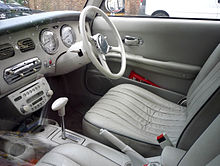Nissan Figaro
| Nissan Figaro (E-FK10) | |
|---|---|
 | |
| Overview | |
| Manufacturer | Nissan |
| Production | 1990 |
| Assembly | Oppama Plant, Yokosuka, Kanagawa, Japan |
| Designer | Naoki Sakai and Shoji Takahashi |
| Body and chassis | |
| Class | Compact car |
| Body style | 2-door convertible |
| Layout | FF layout |
| Platform | Nissan B platform |
| Related | |
| Powertrain | |
| Engine | 987 cc MA10ET I4 turbo |
| Transmission | 3-speed automatic |
| Dimensions | |
| Wheelbase | 2,300 mm (91 in) |
| Length | 3,740 mm (147 in) |
| Width | 1,630 mm (64 in) |
| Height | 1,365 mm (53.7 in) |
| Curb weight | 810 kg (1,790 lb) |
The Nissan Figaro is a two-door 2+2 retro-styled fixed-profile convertible manufactured by Nissan for model year 1991, and originally marketed solely in Japan at their Nissan Cherry Stores.
With its design variously attributed to Naoki Sakai[1] and/or Shoji Takahashi,[2] twenty thousand examples were marketed by Nissan in the convertible's single year of production[3] — all with right hand drive.[4]
Overview
The Figaro was introduced at the 1989 Tokyo Motor Show under the slogan "Back to the Future". The name references the title character in the play The Marriage of Figaro by Pierre Beaumarchais.
Based on the Nissan Micra, the Figaro was built at Aichi Machine Industry,[1] a special projects group which Nissan would later call "Pike Factory," which also produced three other niche automobiles: the Be-1, Pao, and S-Cargo.
As a fixed-profile convertible, the upper side elements of the Figaro's bodywork remain fixed, while its fabric soft top retracts to provide a less fully open experience than a typical convertible. The fixed-profile concept is seen on other convertibles, including the Citroën 2CV (1948–1990), the Nash Rambler Convertible "Landau" Coupe (1950), and the 1957 Fiat 500 — as well its 2007 Fiat 500 successor.
The Figaro was marketed in four colours representing the four seasons: Lapis Grey (Winter), Emerald Green (Spring), Pale Aqua (Summer) and Topaz Mist (Autumn), listed in order of number produced, highest first. Two additional cars were also painted in different colours.
The Figaro was equipped with leather seats, air conditioning, CD player and a fixed-profile slide-back open roof.
8000 were originally available with an additional 12,000 added to production numbers to meet demand. Total production of the Figaro finished at 20,073 units.[5] Prospective purchasers entered a lottery to purchase a Figaro. Limited edition cars came with passenger side baskets and cup holders.
In 2011, design critic Phil Patton called the four Pike cars "the height of postmodernism"[2] and "unabashedly retro, promiscuously combining elements of the Panhard Dyna Junior, Citroën 2CV, Renault 4, Mini [and] Fiat 500."[2]
Specifications



- Steering: Rack and pinion
- Suspension: Four-wheel independent
- Front: Strut-type
- Rear: 4-link,solid axle, with stabilizer bar (anti-roll bar)
- Front wheel drive
- Brakes: Power-assisted ventilated front discs, rear drums
- Tire size: 165/70R12 77H Cold climate spec: 155SR12 (155/80R12)
- Weight
- Kerb weight: 810 kg (1786 lb)
- Max laden weight: 1235 kg (2723 lb)
- Max rolling weight: 1835 kg (4045 lb)
- Max load (front axle): 620 kg (1367 lb)
- Max load (rear axle): 625 kg (1378 lb)
- Max trailer weight (without brakes): 310 kg (683 lb)
- Max trailer weight (with brakes): 600 kg (1323 lb)
- Performance
- Turning circle (kerb to kerb): 4.7 m (15 ft 5 in)
- Fuel economy: 7.3 L/100 km (39 mpg‑imp; 32 mpg‑US)
- Fuel consumption rate: 60 km/h (37 mph) running, on level ground: 4.1 L/100 km (69 mpg‑imp; 57 mpg‑US)
- Top speed: 106 mph (170.59 km/h)
- Engine
- Bore and stroke: 68.0 mm × 68.0 mm (2.68 in × 2.68 in)
- Compression ratio: 8.0:1
- Max power: 77 PS (57 kW; 76 hp) at 6000 rpm
- Max torque: 10.8 kg⋅m (106 N⋅m; 78 lb⋅ft) at 4400 rpm
- Fuel delivery: ECCS (ECU-controlled multi-point injection)
- Fuel type/capacity: Super unleaded/40L (8.8 imp gal or 10.6 US gal)
- Features
- Three-point seat belts (no airbags)
- Rear seat: Three-point seat belts
- Driver's seat belt not fastened warning (buzzer)
- High-mount stop lamp
- Genuine leather seats standard equipment
- Low-mount headrest
- Synthetic leather piping
- Top
- Retractable fabric top with fixed-profile two-tone bodywork
- Top fully retracts into concealed nacelle.
- Top equipped with a double lock and warning buzzer as a safety feature
- Secondary hood latch
- Glass rear window with defrosters
- Body
- Flush mount apron and flush mount fender
- Glassfibre resin material with an outer gel coat atr front fenders and front grill surround
- Fluoroplastic paint
References
- ^ a b McAleer, Brendan (July 28, 2015). "No matter how you slice it, the pint-sized Nissan Figaro is just plain fun". Driving.CA.
- ^ a b c Patton, Phil (March 18, 2011). "Nissan's Cartoon Cars, Once So Hip". The New York Times.
- ^ Baime, A.J. (April 19, 2016). "How a Nissan Figaro Became an Instant Classic in the U.S." The Wall Street Journal.
- ^ Cherry, Jim (May 7, 2010). "1991 Nissan Figaro: Back to the future in Pee Wee Herman's dream car". The Examiner.com.
- ^ Dodd, Mark (September 9, 2017). "EN-FK10-Figaro". GTR-Registry.com.
![]() Media related to Nissan Figaro at Wikimedia Commons
Media related to Nissan Figaro at Wikimedia Commons
